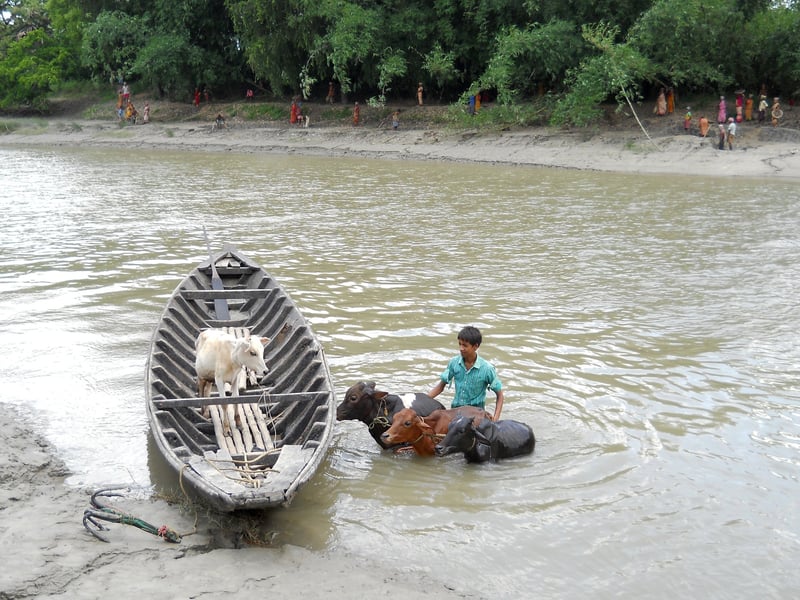
Governments must do more to reduce devastation caused by Tsunamis
News
On World Tsunami Awareness Day, World Animal Protection is calling on the central government and governments in coastal states and union territories in India to take meaningful steps to reduce the devastating impacts tsunamis have on vulnerable communities and their animals.
According to the National Disaster Management Authority (NDMA), nearly 5,700 km (approximately 76%) of India's 7,516 km coastline is prone to tsunamis and tsunami-like storm surges brought by cyclones. This includes thirteen vulnerable States and Union Territories. Since 1970, there have been six major cyclones or tsunamis in India. Together, these caused the deaths of over 32,000 people, 40,000 cattle, scores more animals, while also damaging over 430,000 acres of land.
“We urge governments to adopt risk reduction strategies for protecting animals at both national and state levels to reduce devastation caused by tsunamis and impacts on livelihoods of vulnerable coastal communities,” said Gajender K Sharma, India Country Director at World Animal Protection.
Recently, World Animal Protection responded in the aftermath of the massive earthquake and tsunami that struck Sulawesi, Indonesia on September 28 2018, killing 2,000 people, displacing over 70,000 and leaving at least 680 unaccounted for. Thousands of animals also died and many more were left injured, abandoned and without food or water. Emergency treatment to 3,000 injured or ill pets, goats and cattle was provided.
Building on our initial emergency response, World Animal Protection is working with the Sulawesi Veterinary Association to develop risk reduction measures to avoid a repeat of the terrible events of September. It is critical communities understand their vulnerability and risks from natural hazards such as tsunamis. Often, even if early warning systems are in place, the deadly waves arrive before people can be alerted of the approaching danger. We urge coastal communities to consider earthquakes as the most reliable early warning system and they should take immediate steps to evacuate low lying areas.
“While in many ways on a national level India has taken positive steps to protect animals from disasters, it has been over five years since the National Disaster Management Authority (NDMA) instructed the states on 27th August 2013 to incorporate provisions mentioned in the Chapter 6 of the NDMA Guidelines on Management of Biological Disasters. The tragedy in Sulawesi demonstrates the need for greater awareness of the risks posed by tsunamis. The states and union territories in India should take proactive steps in preparing their State Animal Disaster Management Plans with the necessary resources and ensure that the needs of animals are addressed before, during and after any disaster. World Animal Protection is happy to provide any technical expertise needed to develop risk reduction measures,” Gajender added further.
The Global Picture:
World Animal Protection works to ensure risk reduction plans include animals. Too often, we have seen people disregard warnings or stay in hazardous areas trying desperately to save their animals- frequently their only source of income and companionship.
One billion of the world’s poor depend on livestock to survive. They are among the 2.5 billion small-scale farmers, herders, pastoralists, fishers and forest-dependent communities that each rely on animals for their livelihoods.
These animal-dependent communities are extremely vulnerable to natural disasters; many of the countries with the highest densities of livestock keepers are also those with high multi-hazard ratings. A comprehensive study of 78 post-disaster needs assessments covering 48 developing countries found that crop and livestock losses amounted to more than $24 billion in economic losses. Moreover, globally, the livestock sector absorbs nearly 8.3% of disaster impacts.
The theme of this year’s World Tsunami Awareness Day is reducing disaster economic losses in relation to global GDP by 2030. This is Target C of the Sendai Framework for Disaster Risk Reduction, an international agreement adopted by UN member states in 2015. After years of lobbying, World Animal Protection was pleased to see the Framework include livestock among the essential “assets” that must be protected and accounted for.
Reducing economic losses in disasters must include the protection of animals. Their importance in household, local and national economies is clear. It is both a moral choice as well as a crucial step to safeguarding food security and livelihoods; reducing hunger and poverty and promoting sustainable economic growth.
“We urge governments to adopt risk reduction strategies for protecting animals at both national and state levels to reduce devastation caused by tsunamis and impacts on livelihoods of vulnerable coastal communities, said Gajender K Sharma, India Country Director at World Animal Protection.